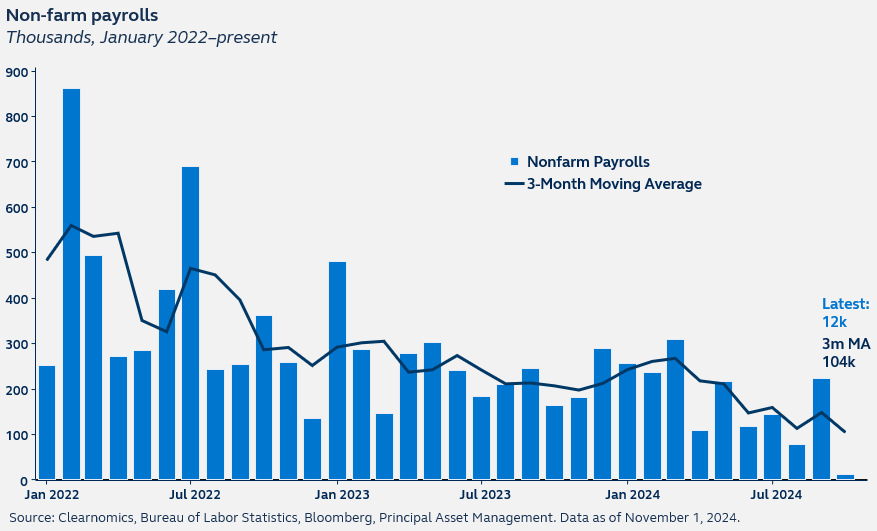A weather-distorted labour report
The October jobs report was significantly weaker than the previous month. Still, with the data likely heavily affected by hurricanes Helene and Milton, it is difficult to decipher the underlying state of the labor market. From a Federal Reserve (Fed) standpoint, the murkiness of the data suggests that the central bank should look through today’s jobs numbers and persist with their planned policy rate path. A 25bps cut at both the November and December FOMC meetings is still on the cards.

Report details
- Total non-farm payrolls increased by 12,000 in October. This is well below consensus expectations, which had been calling for 100,000, reflecting the potential hit from the hurricanes and strike activity. Additionally, this was a decline from the downwardly revised 223,000 rate last month. Parsing the signal from this month’s weak employment growth is difficult, however, as the BLS has been unable to quantify the impact of hurricanes Helene and Milton.
- Weather-sensitive sectors generally showed the most weakness. Manufacturing payrolls saw a 46,000 decline, the largest decline since April 2020, due to both hurricane activity and strike activity (Boeing). Payrolls in the construction, leisure and hospitality sectors were also very soft, likely due to hurricane-related impacts, although it is difficult to quantify. Meanwhile, professional and business services payrolls dropped, largely due to decreases in temporary help, which is typically a bellwether for labour demand.
- Job gains were essentially unchanged across most other sectors, with healthcare and government seeing the largest gains. Growing at a steady, albeit declining, clip, both sectors have continued to benefit from a catch-up in hiring, with the latter also more recently benefiting from the elections.
- The household survey, which is used to calculate the unemployment rate, also showed weakness, with employment declining by 368,000. The unemployment rate stayed steady at 4.1% amid a decline in the labour force, as the participation rate ticked lower to 62.6%—the first decline since May.
- Average hourly earnings accelerated by 0.4% in the month, which was higher than expected, bringing the annual rate to 4.0%, an increase from the prior month’s downwardly revised 3.9%. Earnings growth has so far remained solid, indicating that workers still have bargaining power, with the three-month annualised rise in wages picking up to 4.5%.
Policy outlook
With the hurricanes taking a heavy toll on today’s jobs numbers, it is doubtful that Friday's labour report will prompt a knee jerk reaction from the Fed.
However, a closer examination of the numbers suggests that beneath all the noise and disruption is a softening labour market. The consensus forecast for a 100,000 increase in payrolls was already considering the hurricane effect, so the significant downside surprise potentially indicates underlying weakness.
Today’s report reaffirms that the Fed must persist with a gradual easing cycle despite the surprisingly strong economic activity data in recent weeks. We continue to expect a 25bps cut in both November and December.

